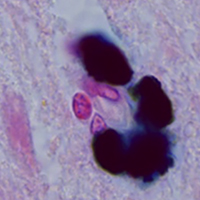Changes in cytoplasmic and extracellular neuromelanin in human substantia nigra with normal aging

Submitted: 31 May 2021
Accepted: 22 July 2021
Published: 1 September 2021
Accepted: 22 July 2021
Abstract Views: 1042
PDF: 497
HTML: 12
HTML: 12
Publisher's note
All claims expressed in this article are solely those of the authors and do not necessarily represent those of their affiliated organizations, or those of the publisher, the editors and the reviewers. Any product that may be evaluated in this article or claim that may be made by its manufacturer is not guaranteed or endorsed by the publisher.
All claims expressed in this article are solely those of the authors and do not necessarily represent those of their affiliated organizations, or those of the publisher, the editors and the reviewers. Any product that may be evaluated in this article or claim that may be made by its manufacturer is not guaranteed or endorsed by the publisher.
Similar Articles
- Matias Garrido, Camila Escobar, Constanza Zamora, Carolina Rejas, Juan Varas, Mario Párraga, Sebastián San Martin, Sandra Montedonico, Bile duct ligature in young rats: A revisited animal model for biliary atresia , European Journal of Histochemistry: Vol. 61 No. 3 (2017)
- Tadashi Yasui, Hiroshi Gomi, Taishi Kitahara, Azuma Tsukise, Ultrastructure and immunohistochemical characterization of proteins concerned with the secretory machinery in goat ceruminous glands , European Journal of Histochemistry: Vol. 61 No. 3 (2017)
- A.C. Croce, G. Bottiroli, Autofluorescence spectroscopy and imaging: a tool for biomedical research and diagnosis , European Journal of Histochemistry: Vol. 58 No. 4 (2014)
- Claudio Casali, Stella Siciliani, Lorena Zannino, Marco Biggiogera, Histochemistry for nucleic acid research: 60 years in the European Journal of Histochemistry , European Journal of Histochemistry: Vol. 66 No. 2 (2022)
- Y. Kaneko, N. Onda, Y. Watanabe, M. Shibutani, Identification of 5-hydroxytryptamine-producing cells by detection of fluorescence in paraffin-embedded tissue sections , European Journal of Histochemistry: Vol. 60 No. 3 (2016)
- Anett Kristin Larsen, Jaione Simón-Santamaría, Kjetil Elvevold, Bo Göran Ericzon, Kim Erlend Mortensen, Peter McCourt, Bård Smedsrød, Karen Kristine Sørensen, Autofluorescence in freshly isolated adult human liver sinusoidal cells , European Journal of Histochemistry: Vol. 65 No. 4 (2021)
- C. Fede, G. Albertin, L. Petrelli, M.M. Sfriso, C. Biz, R. De Caro, C. Stecco, Hormone receptor expression in human fascial tissue , European Journal of Histochemistry: Vol. 60 No. 4 (2016)
- F. Cau, E. Pisu, C. Gerosa, G. Senes, F. Ronchi, C. Botta, E. Di Felice, F. Uda, V. Marinelli, G. Faa, V. Fanos, C. Moretti, D. Fanni, Interindividual variability in the expression of surfactant protein A and B in the human lung during development , European Journal of Histochemistry: Vol. 60 No. 3 (2016)
- Federico Angelo Cazzaniga, Edoardo Bistaffa, Chiara Maria Giulia De Luca, Giuseppe Bufano, Antonio Indaco, Giorgio Giaccone, Fabio Moda, Sporadic Creutzfeldt-Jakob disease: Real-Time Quaking Induced Conversion (RT-QuIC) assay represents a major diagnostic advance , European Journal of Histochemistry: Vol. 65 No. s1 (2021): Special Collection on Advances in Neuromorphology in Health and Disease
- Yuan Cao, Dong-Hui Ao, Chao Ma, Wen-Ying Qiu, Yi-Cheng Zhu, Immunoreactivity and a new staining method of monocarboxylate transporter 1 located in endothelial cells of cerebral vessels of human brain in distinguishing cerebral venules from arterioles , European Journal of Histochemistry: Vol. 65 No. s1 (2021): Special Collection on Advances in Neuromorphology in Health and Disease
<< < 5 6 7 8 9 10 11 12 13 14 > >>
You may also start an advanced similarity search for this article.

 https://doi.org/10.4081/ejh.2021.3283
https://doi.org/10.4081/ejh.2021.3283










